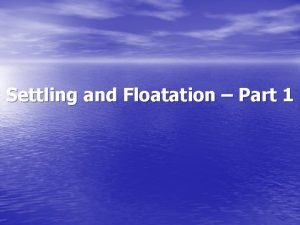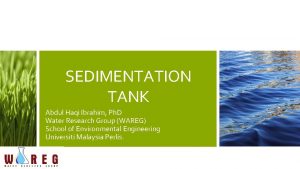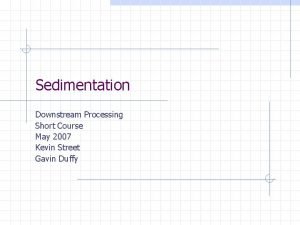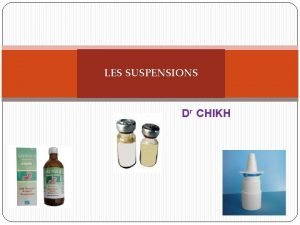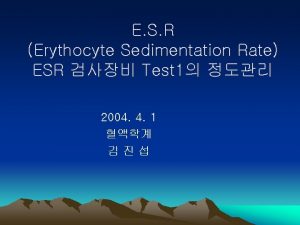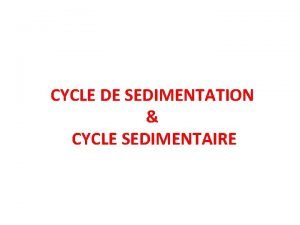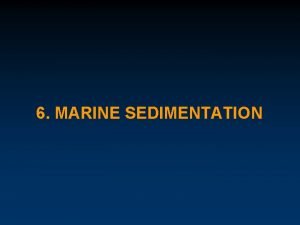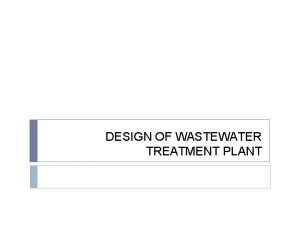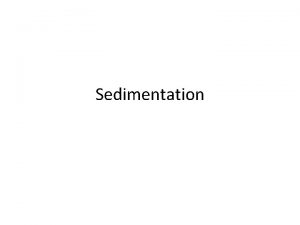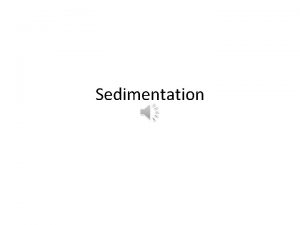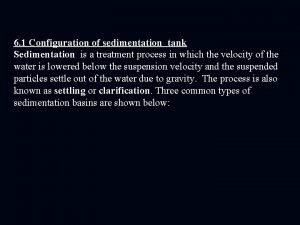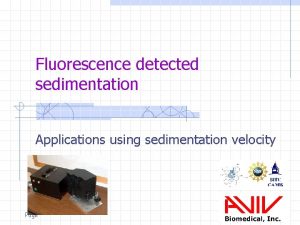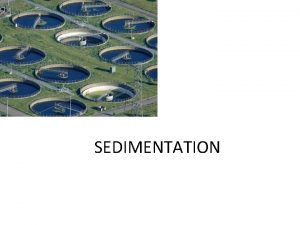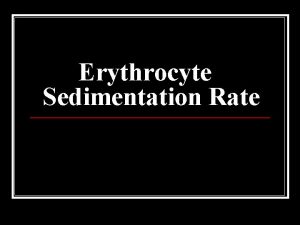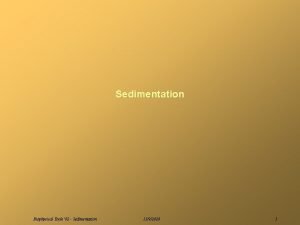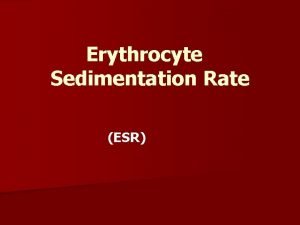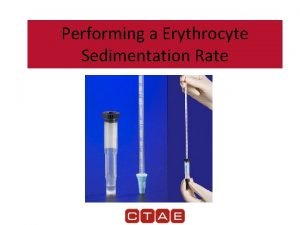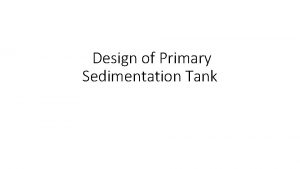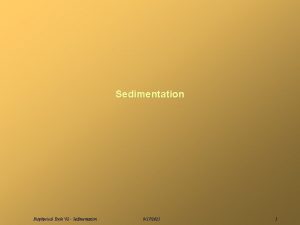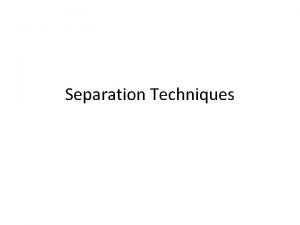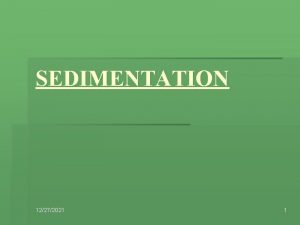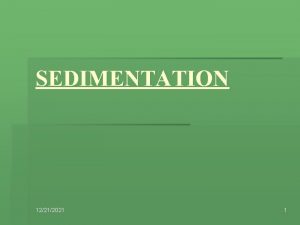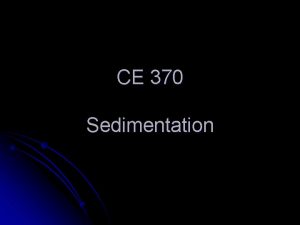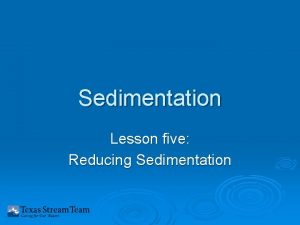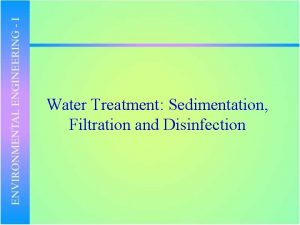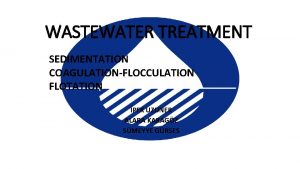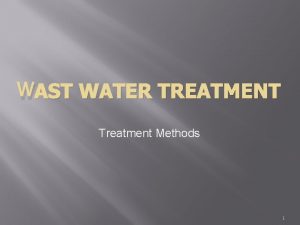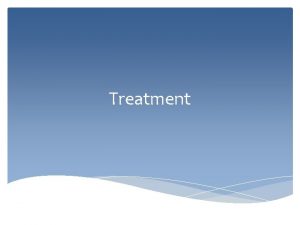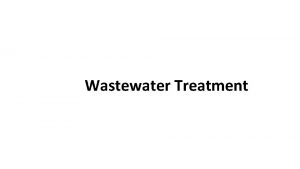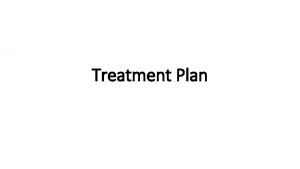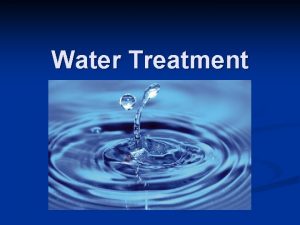Sedimentation Sedimentation is a physical treatment process that

























- Slides: 25

Sedimentation

• Sedimentation is a physical treatment process that utilize a gravity separate suspended soilds from water. In general, there are four types of sedimentation:

• Type I : known as discrete setling describes the sedimentation of low concentration of particles that settle as individual entities. Un this type of settling the particles settle unhindered at a constant velocity through water.

• Type 2 Known as flocculant settling, describes sedimentation of larger concentration of solids that agglomerate as they settle. The particles begins to settle as discrete particles but their concentration is sufficiently high to ensure particle collision.

Type 3 Known as hindered settling describes the sedimentation of a suspension with solids concentration sufficiently high to cause the particles to settle as a mass e. g. the upper portion of the sludge blanket behave like type 3

• Type 4 • Known as compression settling , describes the sedimentation of suspension with soilds concentration so high that the particles are in contact with an another and further sedimentation can occur only by compression of the mass







14. 0 PRINCIPLES OF HORIZONTAL FLOW SEDIMENTATION TANKS Given below are the principles of good sedimentation tank design. (a) In a continuous flow sedimentation tank, four zones must be present. i) an inlet zone to disperse influent flow and suspended matter uniformly over the cross section of the basin, ii) a settling zone in which settling takes place, iii) an outlet zone in which clarified water is collected uniformly over the cross-section of the tank and directed to the outlet conduit, and iv) a sludge zone at the bottom in which the settled solids accumulate and from which they are withdrawn for disposal.

(b) The criteria of settling in a horizontal flow tank are : i) settling rate “S” depends on particle size, shape and mass density, ii) efficiency of a tank depends on the surface loading (or overflow rate) “So”, which is given by “So” = Q/A where Q is the rate of flow and A is the surface area, iii) clarification effect depends on frequency distribution for the settling velocities of the suspended particles and the value “So” which can be influenced by the design of the tank, size, shape and mass density of the particles, iv) efficiency is independent of depth “H” of the tank and of detention time “To”, and v) particles settle faster with depth due to part of the settling particles coalescing to form larger particles which settle at rates higher than the parent particles.

(c) is In an ideal horizontal flow sedimentation tank, settling supposed to take place without any influence of the horizontal water movement (hazen and Camp model – concept of overflow rate). In practice, however, horizontal flow sedimentation tanks operate at efficiencies less than that for ideal horizontal flow because : = (i) and scatter the and there is influence by horizontal water movement transverse velocity components which pathways of discreet particles (ii) some distrubance is always present due to unequal supply of flocculated water causing eddying currents, stagnant water, wind induced currents or unequal abstraction of clarified water over the width of the tanks.

Settling Velocities for common suspensions Nature of Solid Specific Gravity Settling Velocity (m/h) Sand, Silt, Clay 2. 650 0. 25 Aluminium and Iron Floc 1. 002 2. 99 Calcium Carbonate Precipitates 1. 200 1. 51 Primary Waste Organic 1. 001 1. 51 Activated Sludge Organics 1. 005 7. 20 Source : Clarifier Design, Water Environment Federation (WEF), 2005

15. 1 SEDIMENTATION Sedimentation allows the flocs to fall to the bottom in a sedimentation tank. These tanks are normally sized in accordance with the surface loading theory, which means that the particles to be separated must have sufficient time to sink to the bottom while the water passes through the tank. If the settlement velocity of the particles is V m/h, the water flow rate is Q m 3/h and the surface area of the sedimentation tank is A m 2, we obtain the following relationship : Vm/h m 3/h = Q A m 2

15. 2 Rectangular Sedimentation Tank The design criteria for rectangular horizontal flow sedimentation tank are as follows: (a) The overflow rater ranges from 0. 85 to 1. 5 m 3/m 2/hr. However, the rate commonly used is 1. 5 m 3/m 2/hr. (b) Detention time 2 – 4 hours (c) The length to width ratio is between 3 : 1 and 5 : 1. Preferred one being 4 : 1

(d) The depth is in the range of 3 to 5 meters (e) Diffuser wall is required at the inlet where the velocity should be not more than 0. 1 m/s (f) Loading outlet over weir should not exceeds 8 m 3/hr/m (per meter run) (g) Space to be provided for accumulation of sludge should be 10 to 15% of the tank volume. (h) Floor slope is recommended to be 1: 50

15. 3 Design of Rectangular Sedimentation Tank Surface Rate(m/h), V = Q = 3500 m 3/h V = 1. 5 m/hr Q m 3/h A m 2 Propose: Provide Ten (10) Rows of sedimentation tank Q 8 = 350 m 3/hr

Surface Rate (m/h), V Area, A = Qm 3/h A m 2 = 350 m 3/hr 1. 5 m/hr = 233 m 2 Retention time, say t = 4 hours Tank capacity, Volume = 15% Sludge 233 m 3/h x 4 h = 932 m 3 = 1072 m 3 d = Proposed Length to Width ratio 4 : 1 4. 6 m depth

4 B 2 = 233 B = 7. 63 m L = 30. 53 m d = 4. 6 m 30. 53 m x 7. 35 m 1 7. 63 m 2 7. 63 m 3 7 x 7. 63 m 10

15. 4 “Lovo” Sedimentation Tank The design criteria is as follows: (a) Surface loading should not exceed 1. 5 m 3/m 2/hr. (b) Detention time must not be less than 2 hrs. (c) Length to width ratio is between 2: 1 and 4: 1

(d) The depth recommended is 3 to 5 meters (e) A certain quantity of sludge accumulation (10 to 15% of tank capacity) should be allowed for in computing the capacity of the tank. (f) Inlet velocity into the sedimentation tank should be in the region of 0. 1 m/sec where as the outlet weir loading should be about 8 m 3/hr/m.

(g) The velocity of flow at mid-channel in the bottom half (Q/x-sectional Area) should not be greater than 0. 05 m/sec. In practice however 0. 03 m/s is commonly used in design. For the top half, 0. 04 m/s is the design velocity. (h) The overflow should be positioned at the furthest end from the inlet and should be of sufficient size to cope with the over flow rate. (i) The floor slopes towards the inlet end at a gradient of 1 in 18 to 1 in 24, intermediate slanting slab that spans the whole width of the tank rises towards the collecting channel at the same range of gradients.
 Ngoại tâm thu thất chùm đôi
Ngoại tâm thu thất chùm đôi Block xoang nhĩ
Block xoang nhĩ Thể thơ truyền thống
Thể thơ truyền thống Thơ thất ngôn tứ tuyệt đường luật
Thơ thất ngôn tứ tuyệt đường luật Walmart thất bại ở nhật
Walmart thất bại ở nhật Tìm độ lớn thật của tam giác abc
Tìm độ lớn thật của tam giác abc Con hãy đưa tay khi thấy người vấp ngã
Con hãy đưa tay khi thấy người vấp ngã Tôn thất thuyết là ai
Tôn thất thuyết là ai Gây tê cơ vuông thắt lưng
Gây tê cơ vuông thắt lưng Sau thất bại ở hồ điển triệt
Sau thất bại ở hồ điển triệt Different methods of size sepration are
Different methods of size sepration are Examples of floating and settling
Examples of floating and settling Sedimentation
Sedimentation Sedimentation in downstream processing
Sedimentation in downstream processing Erythrocyte sedimentation rate principle
Erythrocyte sedimentation rate principle Formal ether concentration technique
Formal ether concentration technique Loi de stockes
Loi de stockes Erythocyte sedimentation rate
Erythocyte sedimentation rate Sedimentation technique for stool concentration
Sedimentation technique for stool concentration Cycle de sédimentation
Cycle de sédimentation Sedimentation technique for stool concentration
Sedimentation technique for stool concentration Ova cysts and parasites
Ova cysts and parasites Facies marine
Facies marine Clarifier tank in wastewater treatment
Clarifier tank in wastewater treatment 4lovo
4lovo Acid ether sedimentation technique
Acid ether sedimentation technique











